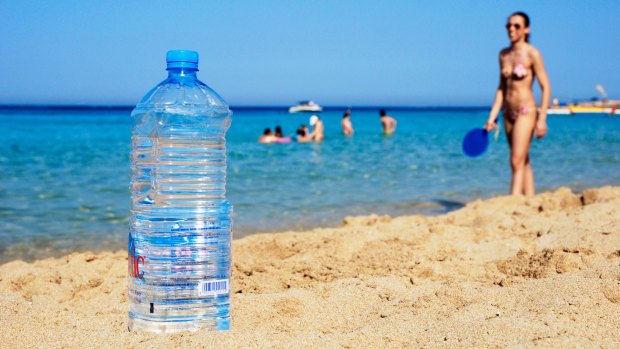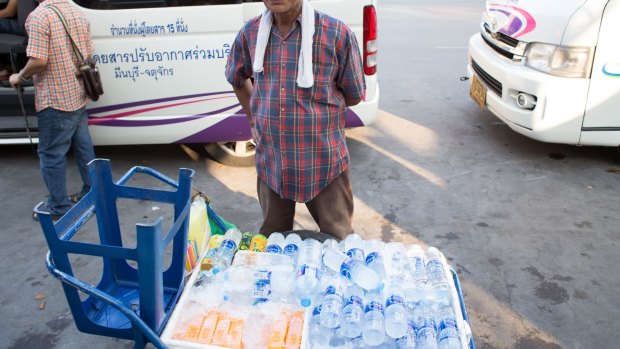This was published 5 years ago
Drinking water overseas: Is it safe to always drink bottled water?

Bottled water the fastest-growing sector of the world's beverage market.Credit: Alamy
You're wandering about on the Greek island of Santorini or admiring the ruins of Angkor, it's hot so you grab a bottle of water from a local vendor. It's the safe, sane thing to do, right? The bottle is sealed, the label says "pure water", but maybe what's inside is not so natural. Would you still be drinking it if you knew that more than 90 per cent of all bottled water sold around the world contains microplastics?
That's the conclusion of a study released earlier this year which analysed 259 bottles from 11 brands sold in nine countries, revealing an average of 325 plastic particles per litre of water. These microplastics included nylon, polypropylene and polyethylene terephthalate, commonly known as PET, and widely used in the manufacture of clothing and food and liquid containers.
The study was conducted at the State University of New York on behalf of Orb Media, a Washington, DC-based journalism organisation.

When travelling in developing countries, do you buy water in plastic bottles or take your chances with tap water?Credit: Shutterstock
Confronted with this evidence, several bottled-water manufacturers including Nestle and Coco-Cola conducted their own studies using the same methodology which showed that their water did contain microplastics, but far less than the Orb study suggested.
Regardless, the World Health Organisation has now launched a review into the potential health risks of drinking water from plastic bottles.
Bottled water, the one we trust
About a million bottles are bought every minute, not only by thirsty tourists but also by many of the 2.1 billion worldwide who live with unsafe drinking water.
Bottled water the fastest-growing sector of the world's beverage market, with sales valued at around $US157 billion ($A214 billion) annually and consumption of around 300 billion litres per year. That's about equal to the amount of water flowing over the American Falls and Bridal Veil Falls at Niagara in six days.
From Addis Ababa to Zanzibar, it's has become ubiquitous. About a million bottles are bought every minute, not only by thirsty tourists but also by many of the 2.1 billion worldwide who live with unsafe drinking water. According to the United Nations, about 4000 children die every day from water-borne diseases which could be prevented if they had access to safe drinking water.
There's no real mystery about how microplastics end up in our water, whether bottled or from a tap. Microplastics are everywhere. Simply washing a single synthetic garment can yield thousands of plastic microfibres.
Microbeads are a subset of microplastics, widely used in the manufacture of shower gels, facial scrubs, cosmetics and toothpaste, among other products. As many as 100,000 microbeads can be flushed down the drain during a single shower according to the UK's Environmental Audit Committee of the House of Commons, and they're light. So light they can easily become airborne. They're in the air we breathe.
As well as its study of bottled water, Orb has also commissioned a study of tap water and more than 80 per cent of the samples we collected on five continents tested positive for the presence of plastic fibres. On average however, tap water around the world contained fewer microfibres than bottled water.
What are the implications for our health? According to a 2016 report by the European Food Safety Authority on the presence of nanoplastics in food , as much as 90 per cent of microplastics that enter the human digestive system will possibly pass through the gut without incident. Of the remainder, some of the smaller particles could enter the lymphatic system, or pass from the bloodstream to the kidneys or liver.
If we're all going to end up with microplastic in our body tissue, what are the likely implications for our health? Are our intestines, our arteries or our livers going to be clogged with congealed lumps of plastic? On that, the jury is still out. The same EFSA study noted "There is a lack of knowledge about the local effects of microplastics in the GI (gastro-intestinal) tract, including microbiota. Toxicological data on the effects of microplastics as such are essentially lacking for human risk assessment."
I'm heading for India in October, so what should I be drinking? Bottled water, likely containing microplastics, or take my chances with the tap water? Even if it's boiled for an adequate period, and therefore unlikely to cause me any harm, there is no guarantee that the water source is itself free of microplastics. But thanks all the same, microplastics aside, I'll be drinking bottled water. I wonder how beer stacks up?
See also: 11 mistakes every first-time traveller makes
See also: Plastic straws are disappearing from hotels and airlines
Sign up for the Traveller newsletter
The latest travel news, tips and inspiration delivered to your inbox. Sign up now.